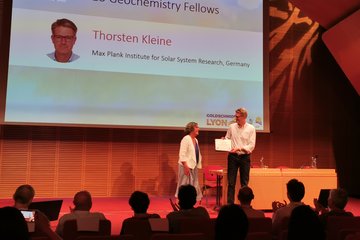Alle Typen
1.
Zeitschriftenartikel
HCN and CN in Comet 2P/Encke: Models of the non-isotropic, rotation-modulated coma and CN parent life time. Icarus 215, S. 153 - 185 (2011)
2.
Zeitschriftenartikel
Interaction of Particles in the Near Field and Opposition Effects in Regolith-Like Surfaces. Solar System Research 43, S. 100 - 115 (2009)
3.
Zeitschriftenartikel
A dynamical model with a new inversion technique applied to observations of Comet WM1 (LINEAR). Icarus 197, S. 183 - 202 (2008)
4.
Zeitschriftenartikel
Rebuttal to comment on Modeling of opposition effects with ensembles of clusters: Interplay of various scattering mechanisms by Elena V. Petrova, Victor P. Tishkovets, Klaus Jockers, 2007 [Icarus 188, 233245]. Icarus 194, S. 853 - 856 (2008)
5.
Zeitschriftenartikel
Modelling of opposition effects with ensembles of clusters: Interplay of various scattering mechanisms. Icarus 188, S. 233 - 245 (2007)
6.
Zeitschriftenartikel
The luminous infrared composite Seyfert 2 galaxy NGC 7679 through the [O III] λ 5007 emission line. Astronomy and Astrophysics 469 (3), S. 891 - 898 (2007)
7.
Zeitschriftenartikel
Multiple scattering of light by densely packed random media of spherical particles: Dense media vector radiative transfer equation. J. Quant. Spectrosc. Radiat. Transf. 101, S. 54 - 72 (2006)
8.
Zeitschriftenartikel
CCD imaging and aperture polarimetry of comet 2P/Encke: are there two polarimetric classes of comets? Astronomy and Astrophysics 441 (2), S. 773 - 782 (2005)
9.
Zeitschriftenartikel
Database of comet polarimetry: Analysis and some results. Earth, Moon and Planets 97 (3-4), S. 365 - 378 (2005)
10.
Zeitschriftenartikel
Polarization and brightness opposition effects for the E-type Asteroid 64 Angelina. Icarus 178 (1), S. 222 - 234 (2005)
11.
Zeitschriftenartikel
The phase curve of cometary dust: Observations of comet 96P/Machholz 1 at large phase angle with the SOHO LASCO C3 coronagraph. Astronomy and Astrophysics 427 (2), S. 755 - 761 (2004)
12.
Zeitschriftenartikel
CCD imaging polarimetry of Comet 2P/Encke. Icarus 168 (2), S. 385 - 391 (2004)
13.
Zeitschriftenartikel
Ground-based photometric observations of Jupiter's inner satellites Thebe, Amalthea, and Metis at small phase angles. Icarus 170, S. 24 - 34 (2004)
14.
Zeitschriftenartikel
The wavelength dependence of the monochromatic extinction coefficient for the observatory on Terskol Peak. Kinematika i Fizika Nebesnykh Tel 20, S. 372 - 378 (2004)
15.
Zeitschriftenartikel
Polarization of Light Scattered by Solar System Bodies and the Aggregate Model of Dust Particles. Solar System Research 38, S. 309 - 324 (2004)
16.
Zeitschriftenartikel
Optical properties of aggregate particles comparable in size to the wavelength. J. Quant. Spectrosc. Radiat. Transf. 86 (3), S. 241 - 265 (2004)
17.
Zeitschriftenartikel
The dust in comet C/1999 S4 (LINEAR) during its disintegration: Narrow-band images, color maps, and dynamical models. Icarus 160, S. 419 - 436 (2002)
18.
Zeitschriftenartikel
Astrometry of comet 46 P/Wirtanen. Minor Planet Circular of Minor Planet Center of IAU MPC 46755-46756 (2002)
19.
Zeitschriftenartikel
Astrometry of comet C/2002 O4 (Hoenig). Minor Planet Circular of Minor Planet Center of IAU MPC 46739 (2002)
20.
Zeitschriftenartikel
Comparative study of the dust polarimetric properties in split and normal comaes. Earth, Moon and Planets 90, S. 167 - 176 (2002)











